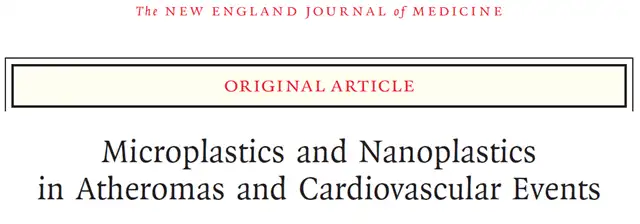Microplastics Linked to Higher Heart Attack and Stroke Risk
- Normal Liver Cells Found to Promote Cancer Metastasis to the Liver
- Nearly 80% Complete Remission: Breakthrough in ADC Anti-Tumor Treatment
- Vaccination Against Common Diseases May Prevent Dementia!
- New Alzheimer’s Disease (AD) Diagnosis and Staging Criteria
- Breakthrough in Alzheimer’s Disease: New Nasal Spray Halts Cognitive Decline by Targeting Toxic Protein
- Can the Tap Water at the Paris Olympics be Drunk Directly?
Microplastics Linked to Higher Heart Attack and Stroke Risk
- Should China be held legally responsible for the US’s $18 trillion COVID losses?
- CT Radiation Exposure Linked to Blood Cancer in Children and Adolescents
- FDA has mandated a top-level black box warning for all marketed CAR-T therapies
- Can people with high blood pressure eat peanuts?
- What is the difference between dopamine and dobutamine?
- How long can the patient live after heart stent surgery?
Microplastics Linked to Higher Heart Attack and Stroke Risk
Every encounter with plastic may harm your cardiovascular system! NEJM: Patients have a risk of heart attack, stroke, and death 3.5 times higher!
Plastic is widely used worldwide, but only 20% of plastic waste can be recycled or incinerated. Most plastic fragments are discharged into landfills or natural environments. According to current trends, the world will produce about 2.4×10^9 tons of plastic waste by 2050. Plastic can persist in the environment for decades or even hundreds of years, undergoing physical wear, chemical reactions, and biodegradation into smaller plastic fragments. If the fragment diameter is <5 mm, it is called “microplastic”; if the diameter is <1000 nm, it is called “nanoplastic.”
Microplastics and nanoplastics (MNPs) are found in drinking water, various foods, cosmetics, and the air, often in combination with inhalable particles in the air with a diameter of 2.5 μm or shorter (such as PM2.5), and are spread by the wind. Multiple studies have shown that MNPs can enter the human body through ingestion, inhalation, and skin contact and interact with body tissues and organs. MNPs have been found in human placenta, lungs, liver, breast milk, and urine. Recent preclinical model studies have suggested that MNPs are a new risk factor for cardiovascular disease.
Recently, a study published in the New England Journal of Medicine (NEJM) showed that patients with detectable MNPs in carotid plaques had a higher risk of myocardial infarction, stroke, or death from any cause during an average follow-up of 34 months. A simultaneous editorial in NEJM stated, “The detection of MNPs in plaque tissue is a breakthrough finding that raises a series of urgent questions, such as whether exposure to MNPs should be considered a cardiovascular risk factor? Besides the heart, what other organs may be affected? How can we reduce the harm of MNPs to the body?”

Image source: NEJM
This prospective, multicenter, observational study analyzed the association between MNP exposure and cardiovascular outcomes in adults with carotid stenosis (>70%, planned for carotid endarterectomy) based on the detection of MNPs in plaques. Researchers simultaneously analyzed 11 different types of MNPs, including common ones like polyethylene and polyvinyl chloride.
The study included 257 participants who completed follow-up, among whom 150 (58.4%) had polyethylene detected in removed carotid plaques, with 31 cases (12.1%) also detecting polyvinyl chloride. The mean levels of polyethylene and polyvinyl chloride were (21.7±24.5) μg/mg plaque and (5.2±2.4) μg/mg plaque, respectively.
Considering the widespread distribution of MNPs, it is almost impossible to attribute the potential sources of MNPs solely to human activities. The focus of this study was not to investigate the potential sources of detected MNPs, and it is also unclear why only polyvinyl chloride and polyethylene were detected in this study, and not other plastics.
The main study endpoint was nonfatal myocardial infarction, nonfatal stroke, or death from any cause. The results showed that during a mean follow-up period of 33.7 months: No detection of MNPs: 8 cases (7.5%) had a major study endpoint event (2.2 events/100 patient-years); Detection of MNPs: 30 cases (20.0%) had a major study endpoint event (6.1 events/100 patient-years); Compared with patients without detected MNPs, those with detected MNPs had a risk of major study endpoint events 3.5 times higher (HR=4.53, 95% CI=2.00~10.27, P<0.001).
In conclusion, this study shows that patients with carotid stenosis >70% who have MNPs detected internally in the carotid artery are at higher risk of heart attack, stroke, or death from any cause compared to those without detected MNPs. The editorial suggests that in the face of the increasingly serious problem of plastic pollution, we may be able to do something, such as:
- Recognizing the harm of plastics, such as their potential impact on atherosclerotic plaque-related outcomes;
- Encouraging patients to reduce the use of plastics, especially unnecessary single-use items;
- Solving the plastic problem is a difficult path that requires continuous attention and effort.
Microplastics Linked to Higher Heart Attack and Stroke Risk
References:
[1] Marfella R, Prattichizzo F, Sardu C, et al. Microplastics and Nanoplastics in Atheromas and Cardiovascular Events. N Engl J Med. 2024 Mar 7;390(10):900-910. doi: 10.1056/NEJMoa2309822. PMID: 38446676.
(source:internet, reference only)
Disclaimer of medicaltrend.org
Important Note: The information provided is for informational purposes only and should not be considered as medical advice.



